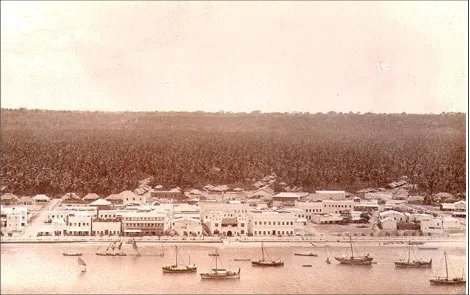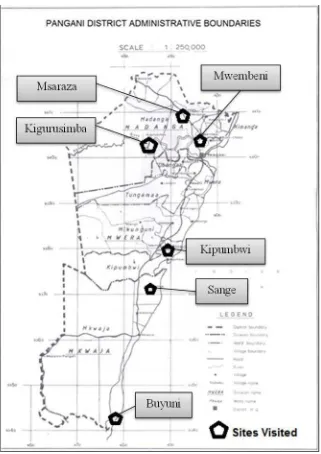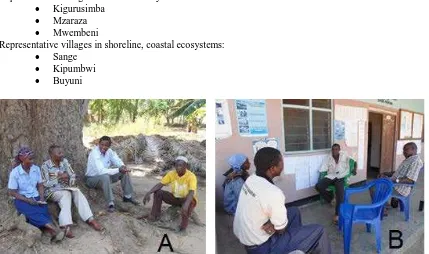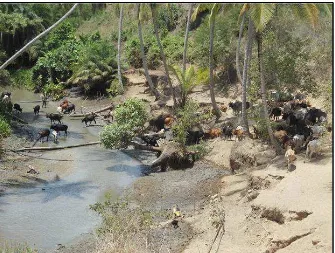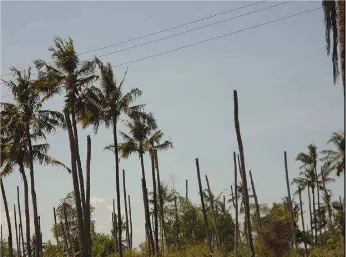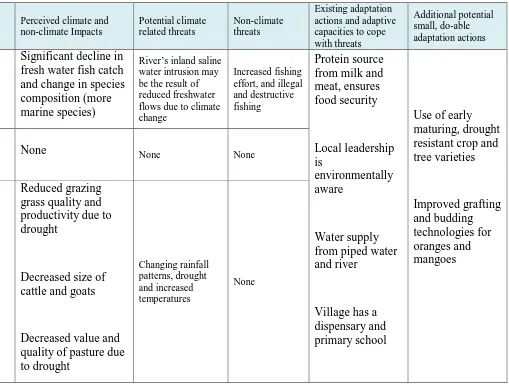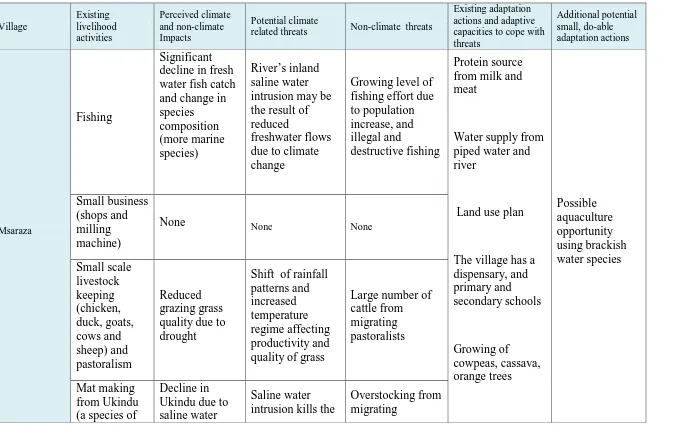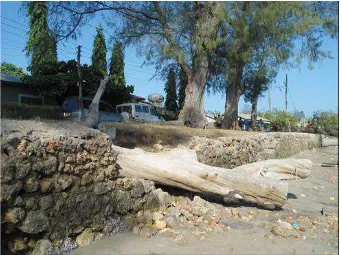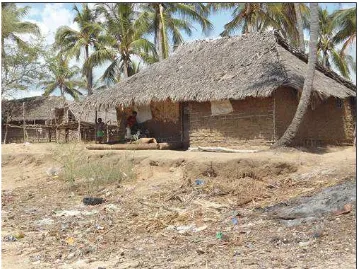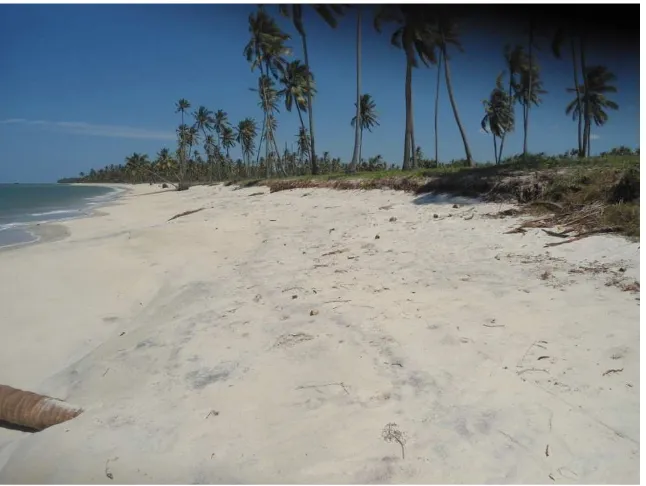Climate Change Adaptation Series: Document 6
LIVELIHOODS, CLIMATE AND NON-CLIMATE THREATS
AND ADAPTATION: PANGANI DISTRICT COASTAL
VILLAGES
April, 2013
Prepared by the Pwani Project
This report is part of the Pwani Project’s Coastal Community Adaptation Series, which includes the following documents:
1. Coastal and Marine Ecosystems in a Changing Climate: the Case of Tanzania. 2. Workshop Proceedings: Tanzania Coastal Climate Change National Adaptation
Planning Workshop
3. Village Vulnerability Assessments and Climate Change Adaptation Planning (V & A): Kitonga, Bagamoyo District
4. Village Vulnerability Assessments and Climate Change Adaptation Planning (V & A): Mlingotini, Bagamoyo District
5. Rapid Assessment of Shoreline Characteristics and Dynamics of the Lazy Lagoon at Mlingotini Village, Bagamoyo
6. Livelihoods, Climate and Non-Climate Threats and Adaptation: Pangani District Coastal Villages
7. Livelihoods, Climate and Non-Climate Threats and Adaptation: Bagamoyo District Coastal Villages
8. Village Vulnerability Assessments and Climate Change Adaptation Planning (V & A): Jambiani and Paje, Zanzibar
9. Village Vulnerability Assessments and Climate Change Adaptation Planning (V & A): Kitonga and Mlingotini Villages, Bagamoyo District (Summary Report) 10.Village Vulnerability Assessments and Climate Change Adaptation Planning (V &
A): Mwembeni, Pangani District
11.Village Vulnerability Assessments and Climate Change Adaptation Planning (V & A): Sange, Pangani District
This publication is available electronically on the Coastal Resources Center’s website at http://www.crc.uri.edu. For more information contact: Coastal Resources Center, University of Rhode Island, Narragansett Bay Campus, South Ferry Road, Narragansett, Rhode Island 02882, USA. Tel: (401) 874-6224; Fax: (401) 874-6920.
Citation: Mahenge, J., Mkama, W., Tobey, J., and Robadue. D. (2012), Livelihoods, Climate and Non-Climate Threats and Actions to Adapt: Six Representative Coastal Villages in Pangani District. Coastal Resources Center, University of Rhode Island, Narragansett, RI, 34 pp.
Table of contents
Contents
Table of contents ... ii
Foreword ... iii
1. INTRODUCTION ... 1
2. VULNERABILITY ASSESSMENT METHODOLOGY ... 4
3. CLIMATE CHANGE TRENDS AND PROJECTIONS ... 6
4. LIVELIHOODS, CLIMATE AND NON-CLIMATE THREATS, AND ADAPTATION: RIVERINE ECOSYSTEMS ... 6
5. LIVELIHOODS, CLIMATE AND NON-CLIMATE THREATS, AND COPING: COASTLINE ECOSYSTEMS ... 16
6. CONCLUDING COMMENTS ... 25
REFERENCES ... 26
APPENDICES ... 27
Appendix 1: Villages in Pangani District with associated Divisions, Wards and sub-villages ... 27
Foreword
Climate change is a global issue posing challenges to the very survival of mankind and preventing sustainable development. The adverse potential impacts of climate change are now evident in Pangani District. Pangani District villages are exposed to climate change and non-climate related stresses. The impacts pose danger to livelihoods, social assets and the natural environment.
One of the visible impacts is on the economically important water sector. The Pangani river basin is already subject to competing uses of water for agriculture, power production and fresh water supply, depriving the lower river and estuary of necessary fresh water inflows. Drought and shifting rainfall patterns resulting from climate change and climate variability would affect the estuary and hydropower even further, while floods from more intense rainfall due to climate change would cause damage to hydropower stations and human settlements along the river basin.
This report seeks to understand the vulnerabilities specific to six coastal communities in the District with the view of providing guidance for planning directed at improving livelihood resilience and reducing vulnerability in communities to climate and non-climate stressors.
Pangani District appreciates the assistance of the University of Rhode Island’s Pwani Project in carrying out this effort and invites village leaders in all Pangani villages to learn from the findings in this report.
Neneka Rashid
1.
INTRODUCTION
There is now wide agreement by most scientists and climate change professionals that climate change and increased climate variability are already occurring and having serious consequences for many African countries, including Tanzania. The predictions from the experts on climate change are that the problems caused by climate changes will increase and make management of coastal ecosystems and improvements to community resilience even more difficult. The following threats are predicted to cause major problems for coastal resources and the well-being, safety, and food security of coastal communities:
1. More unpredictable precipitation (seasonality and intensity)
2. Increases in strong storms 3. Sea level rise
4. Increased sea surface and ambient air temperatures
5. Increased ocean acidification
These climate and chemical threats and the problems they create are in addition to existing local stresses such as deforestation, over fishing, deterioration in water supply and quality, and development pressures.
Beginning in 2010, the University of Rhode Island’s Pwani Project initiated an effort to help local leaders and government to assess climate change impacts and find ways to adapt to current and future climate change impacts in a strategic way using their own resources and knowledge. This is part of a larger coastal management effort in a partnership with the government of Tanzania and the United States Agency for International Development
(USAID). The Pwani Project has a geographic focus on the island of Unguja in Zanzibar and the ecologically important northern coast of mainland Tanzania – Bagamoyo and Pangani Districts. The overall goal is to help sustain the flow of environmental goods and services; revise the trend of environmental destruction of critical coastal habitats; and improve the wellbeing of coastal residents in the Bagamoyo-Pangani and Menai Bay Seascapes.
This report is an overview of climate and non-climate threats to livelihoods in 6 coastal communities in Pangani District (see Figure 2). Pangani is the smallest of the seven districts in Tanga Region. It is administratively divided into 4 divisions and 13 wards. It has a total of 33 villages, coastal and terrestrial combined, which all together have 95 sub villages
(Appendix 1). Pangani District is one of the oldest districts on the coast of Tanzania. According to the 2002 census, the district has a population of 43,920.
Figure 1. A Photo of Pangani Town in 1890.The town has now extended far back in the
2.
VULNERABILITY ASSESSMENT METHODOLOGY
Definitions
Climate Change A shift in the pattern of weather averaged over time due to natural variability or because of human activity
Vulnerability The degree to which a human or natural system is susceptible to, or unable to cope with, adverse effects of climate change. Vulnerability is a function of the types and amount of assets at risk (exposure), the degree to which those assets and people are impacted (sensitivity), and the ability to cope with actual or expected changes (adaptive capacity).
(Planned) Adaptation Is a process of deliberate decision making to take societal actions in response to actual or expected climatic changes or their impacts, so as to reduce harm or exploit beneficial opportunities
Exposure Refers to assets (land, infrastructure, human society) at risk to the impact of climate change
Sensitivity The degree to which assets are sensitive to incurring negative impacts from climate change and climate variability
Adaptive capacity The ability of society to change in a way that makes it better equipped to manage its exposure and/or sensitivity to climate influences. A community with the capacities to adapt is likely to be more resilient or able to recover from stressful events and conditions.
A Climate Change Task Force of nine members was formed from members of the Pangani District ICM Working Group and Pwani Project (Appendix 2). Prior to the field work, the Task Force collected information related to Pangani District from published sources (scientific literature, reports, articles, and papers) and from documents collected from
Figure 3. Climate Change Task Force team at Pangani District Council during the process of literature review and discussion
Visits, observations, and discussions with key informants were made by the Task Force to 6 representative coastal villages (three riverine coastal villages and three villages with shoreline on the Indian Ocean) (Figure 4). Representative villages in riverine ecosystems:
• Kigurusimba
• Mzaraza
• Mwembeni
Representative villages in shoreline, coastal ecosystems:
• Sange
• Kipumbwi
• Buyuni
3.
CLIMATE CHANGE TRENDS AND PROJECTIONS
The overall projections from climate models for coastal Tanzania are that surface water temperature and ambient air temperature will rise, sea level will rise (from the thermal expansion of the sea), the sea will become more acidic from carbon sequestered in the sea which then forms carbonic acid, and areas with bimodal rainfall patterns (e.g. Pangani) will experience increased rainfall and less predictable seasonality and temporal distribution of precipitation. The effects of these precipitation and seasonality changes are both flooding and droughts.
From this starting point, this assessment sought to overlay local knowledge on climate trends that are beginning to show themselves in villages. For example, local knowledge can help answer the basic question: “Has the frequency, magnitude, or timing of precipitation, flooding, or drought events changed in the last several decades?” By integrating best
available scientific data with local knowledge, communities and District government can take responsible action even in situations where there is imperfect climate change information.
4.
LIVELIHOODS, CLIMATE AND NON-CLIMATE THREATS, AND
ADAPTATION: RIVERINE ECOSYSTEMS
Riverine ecosystems in the Pangani area are observed to be exposed to climate and non-climate changes, affecting the natural ecosystem upon which most livelihoods in rural areas depend. Adaptive capacity is low in all of the communities due to poverty and the
degradation or depletion of ecological services and natural resources.
The three riverine villages have very similar climate and non-climate threats and
consequences to livelihoods. These include reduced fresh water fish catch, less productive pasture and livestock productivity, reduced abundance of the palm leaves used to produce mats, and less productive crop agriculture, and die-out of coconut trees due to disease.
The fresh water stream at Kigurusimba village which is the main source of water to rice farms has been affected by sea water intrusion, permitting mangrove (Avicenia marina) to grow (Figure 5) where rice was once cultivated. The inland intrusion of salt water may be the result of reduced freshwater flows in the Pangani River partly due to climate change induced reductions in precipitation. The same area has been invaded by pastoralists with their cattle, leading to serious environmental degradation (Figure 6).
Figure 5. Mangrove trees (Avicenia marina) growing in a formerly freshwater steam connected to the Pangani River at Kigurusimba village, approximately 21 km upstream from the Indian Ocean. Reduced freshwater flows, due in part to reduced precipitation in the water basin from climate change, are thought to be the cause of salt water intrusion.
Table 1. Livelihoods, climate and non-climate threats, and coping actions - Kigurusimba
V
illa
g
e
Existing livelihood activities
Perceived climate and
non-climate Impacts Potential climate related threats Non-climate threats
Existing
adaptation actions and adaptive capacities to cope with threats
Additional potential small, do-able processing (frying)
Significant decline in fresh water fish catch and change in species composition (more marine species)
By the river, Aviccenia marina mangroves are now found. This is a sign of inland saline water intrusion that may be the result of reduced freshwater flows in the Pangani partly due to climate change
Increased fishing effort, and illegal and destructive fishing
Protein source from milk and meat
Strong local government conflict reduction Water supply is from the Pangani river
Land use plan The village has a dispensary and primary school
Possible aquaculture opportunity using brackish water species
Build a livestock auction center in order to increase local government revenue
Construct a slaughter house Research on why cattle and goats Small business
(shops)
Increased number of food
vendors (“Mama Lishe”) None
Growing number of pastoralist
immigrants
Small scale livestock keeping (chickens, ducks, goats, cows, and sheep) and pastoralism
Reduced grazing grass quality and productivity due to drought
Changing rainfall patterns, drought and increased temperatures
Large number of livestock due to migrating pastoralists
Reduced livestock feeding appetite and decreased size of cattle and goats
Changing rainfall patterns, drought and increased temperatures
Large number of livestock due to migrating pastoralists Decreased value and quality of
pasture due to overgrazing, drought and serious soil erosion
Changing rainfall patterns, drought and increased temperatures
Large number of livestock due to migrating pastoralists Mat making from
Ukindu (a species of Decline in abundance of mat Saline water intrusion kills the
V
illa
g
e
Existing livelihood activities
Perceived climate and
non-climate Impacts Potential climate related threats Non-climate threats
Existing
adaptation actions and adaptive capacities to cope with threats
Additional potential small, do-able
adaptation actions
Agriculture (coconut collection, rice, sesame (sim sim), cassava, sweet potatoes, cow peas, areca nuts (Popoo))
Viral disease that affects the upper shoot of old coconut trees
The disease may be related to climate change and climate variability
None
Salt water intrusion in rice paddies
Reduced fresh water flow of the
Pangani river None
Reduced overall agricultural harvest
Unpredictable rainfall patterns and more droughts and flooding events
None
Washing away of crops Rainfall events causing
Table 2. Livelihoods, climate and non-climate threats, and coping actions – Mwembeni
Village Existing livelihood activities
Perceived climate and non-climate Impacts
Potential climate related threats
Non-climate threats
Existing adaptation actions and adaptive capacities to cope with threats
Additional potential small, do-able adaptation actions
Mwembeni
Fishing
Significant decline in fresh water fish catch and change in species composition (more marine species)
River’s inland saline water intrusion may be the result of reduced freshwater flows due to climate change
Increased fishing effort, and illegal and destructive fishing
Protein source from milk and meat, ensures food security
Local leadership is
environmentally aware
Water supply from piped water and river
Village has a dispensary and primary school
Use of early maturing, drought resistant crop and tree varieties
Improved grafting and budding technologies for oranges and mangoes Small business
(shops and milling machine)
None None None
Subsistence livestock keeping (chicken, duck, goats, cattle and sheep)
Reduced grazing grass quality and productivity due to drought
Decreased size of cattle and goats
Decreased value and quality of pasture due
Changing rainfall patterns, drought and increased temperatures
Village Existing livelihood activities
Perceived climate and non-climate Impacts
Potential climate related threats
Non-climate threats
Existing adaptation actions and adaptive capacities to cope with threats
Additional potential small, do-able adaptation actions
Reduced animal appetite due to higher ambient air
temperatures
Growing of cowpeas, cassava, self-budding orange and grafted mango trees
Mat making from Ukindu (a species of palm found in lowland areas)
Decline in abundance of the mat making material
Saline water intrusion kills the palm tree
Large number of cattle from migrating pastoralists
Agriculture (coconut, rice, cassava, sweet potatoes, cow peas, oranges) and beekeeping
Viral disease affects the upper shoots of old coconut trees
Unreliable rainfall for overall agriculture
Saline water intrusion in rice paddies
Washing away of riparian vegetables and crops during fresh
The disease may be related to climate change
None
Unreliable and reduced annual rainfall
Village Existing livelihood activities
Perceived climate and non-climate Impacts
Potential climate related threats
Non-climate threats
Existing adaptation actions and adaptive capacities to cope with threats
Additional potential small, do-able adaptation actions
water floods
Table 3. Livelihoods, climate and non-climate threats, and coping actions – Mzaraza
Village
Existing livelihood activities
Perceived climate and non-climate Impacts
Potential climate
related threats Non-climate threats
Existing adaptation actions and adaptive capacities to cope with threats
Additional potential small, do-able adaptation actions
Msaraza
Fishing
Significant decline in fresh water fish catch and change in species composition (more marine species)
River’s inland saline water intrusion may be the result of reduced
freshwater flows due to climate change
Growing level of fishing effort due to population increase, and illegal and
destructive fishing
Protein source from milk and meat
Water supply from piped water and river
Land use plan
The village has a dispensary, and primary and secondary schools
Growing of cowpeas, cassava, orange trees
Possible aquaculture opportunity using brackish water species Small business
(shops and milling machine)
None None None
Small scale livestock keeping (chicken, duck, goats, cows and sheep) and pastoralism
Reduced grazing grass quality due to drought
Shift of rainfall patterns and increased temperature regime affecting productivity and quality of grass
Large number of cattle from migrating pastoralists
Mat making from Ukindu (a species of
Decline in Ukindu due to saline water
Saline water intrusion kills the
Village
Existing livelihood activities
Perceived climate and non-climate Impacts
Potential climate
related threats Non-climate threats
Existing adaptation actions and adaptive capacities to cope with threats
Additional potential small, do-able adaptation actions
palm found in lowland areas)
intrusion palm tree Pastoralists Shifting of some
fishers partly or wholly to agriculture activities
Introduction of upland irrigation schemes
Agriculture (coconut, rice, cassava, sweet potatoes, cow peace, oranges and
beekeeping)
Viral disease that kills the upper shoots of coconut trees
The disease may be related to climate change and climate variability
None
Reduced rain fed agricultural output (rice)
Unreliable and reduced annual rainfall
None
Washing away of riparian vegetables and crops during fresh water floods
More severe rainfall
5.
LIVELIHOODS, CLIMATE AND NON-CLIMATE THREATS, AND
COPING: COASTLINE ECOSYSTEMS
Climate and non-climate threats in shoreline coastal villages are similar to those of coastal, riverine villages, but the decline in marine fisheries and reduced abundance, and shoreline erosion are more vivid. There are many causes of erosion and accretion, and sea level rise and higher wind/more severe rain storms due to climate change, are not the only culprits. Natural processes, nearshore development and habitat change, coral reef destruction, mangrove and seagrass destruction are the primary causes of erosion, but climate change exacerbates these other causes.
Whatever is the main culprit, the impacts of erosion can be very costly. The photo below shows a section of sea wall that eroded in historic Pangani town at the mouth of the Pangani River, which resulted in the collapse of nearby homes (Figure 8).
Figure 8. Photo of Pangani river wall near UZIKWASA Office, March 2012
The location of the eroded sea wall would be located in the historic photo in Figure 1 above. What was once a white beach riverfront is now experiencing high tide waves so high and strong that the water flows into the streets.
Figure 9. Beach erosion in Buyuni Village
Figure 10. This tidal pool at Buyuni was once covered with vegetation. Natural processes, climate and non-climate stressors are probably all at play
Table 4. Livelihoods, climate and non-climate threats, and coping actions - Buyuni
Village
Existing livelihood activities
Perceived climate and non-climate Impacts
Potential climate related threats
Non-climate threats
Existing adaptation actions and adaptive capacities to cope with threats
Additional potential small, do-able
adaptation actions
Buyuni
Fishing and fish processing (salt and sun drying)
Significant decline in fish catch and serious beach erosion at landing site
Sea surface temperature rise may change fish distribution, seasonality, reproduction patterns and health
Overfishing and destructive fishing (e.g. beach seine and dynamite fishing)
A land use plan to a new village site will reduce
sensitivity to climate change impacts
Vegetable pot gardening
Replanting “myaa” to stabilize the beach
Mangrove replanting Small business
(kiosk) None None None
Subsistence livestock keeping (chicken and goats)
None None None
Mat making from the leaves of the palm tree Hyphaena
Reduced
abundance of raw material
Saline water intrusion affects its growth
Village
Existing livelihood activities
Perceived climate and non-climate Impacts
Potential climate related threats
Non-climate threats
Existing adaptation actions and adaptive capacities to cope with threats
Additional potential small, do-able
adaptation actions
Salt making
Unpredictable weather patterns for solar drying
Changing
seasonality of rainy seasons
None
Agriculture (coconut)
Viral disease that kills the upper shoots of coconut trees
The disease may be related to climate change and variability
None
Elephants attack crops during the dry season.
Decreased amount of fodder during dry season due to climate change related droughts
Possible increased elephant
population in SANAPA or migration
Serious beach erosion, washing out coconut trees
Sea level rise and/or increased wind speed driving erosion
Table 5. Livelihoods, climate and non-climate threats, and coping actions - Sange
Village
Existing livelihood activities
Perceived climate and non-climate Impacts
Potential climate
related threats Non-climate threats
Existing adaptation actions and adaptive capacities to cope with threats
Additional potential small, do-able adaptation actions
Sange
Fishing and fish processing (frying)
Significant decline in fish catch
Sea surface temperature rise may change fish distribution, seasonality, reproduction patterns and health
Overfishing and
destructive fishing (e.g. beach seine and
dynamite fishing)
Water source is shallow wells Village has a land use management plan
Village has a dispensary and primary school
The community has knowledge about sea turtle conservation (potential for ecotourism)
The village grows drought resistant crops( e.g. sesame, cassava and sweet potatoes) livestock keeping (goats, cattle, sheep, and
chickens)
Reduced grazing grass quality
Changed rainfall patterns have affected grass productivity and quality
Too many cattle due to herds of migrating pastoralists
Village
Existing livelihood activities
Perceived climate and non-climate Impacts
Potential climate
related threats Non-climate threats
Existing adaptation actions and adaptive capacities to cope with threats
Additional potential small, do-able adaptation actions
spp.“miyaa”
Bee keeping in mangrove areas
Decreased honey production because bees spend more time in fanning juvenile bees than foraging and good forage from flowering plants is now more unpredictable
Warming and changes in precipitation patterns may reduce the productivity of bee foraging areas
Salt making is by boiling which encourages mangrove deforestation affecting flowering pattern. Flowering pattern affects honey production
Salt making None None None
Agriculture (coconut, rice, sesame (simsim), cassava, cashew nuts, and sweet potatoes)
Viral disease that kills the upper shoots of coconut trees
The disease may be related to climate change and climate variability
None
Unreliable rainfall affecting rice production
reduced and shifting rainfall patterns
Destruction of land suitable for
agriculture in search for food and water
Saline water intrusion, creating saline soils
Migrating pastoralists in search for food and water
Elephants attack during
dry season None
Table 6. Livelihoods, climate and non-climate threats, and coping actions – Kipumbwi
Village Existing livelihood activities
Perceived climate and non-climate Impacts
Potential climate related threats
Non-climate threats
Existing adaptation actions and adaptive capacities to cope with threats
Additional potential small, do-able adaptation actions
Kipumbwi
Fishing, processing and storage
(freezing, frying)
Fish catch
Sea surface temperature rise may change fish distribution, seasonality, health and reproduction patterns
Dynamite fishing from neighboring villages
Water supply from water taps (faucets) and wells
The village has a dispensary and primary school
The community has knowledge about sea turtle conservation
(potential for ecotourism)
MACEMP project provided boats and engines for fishing further off shore
Corals and mangroves in
Mangrove replanting-Environment committee and school children to ensure sustainability Promote sea turtle illegal cutting and
exportation of mangroves
Crab fattening
Weather and tidal variability at the Mafreta river
Fluctuating and unpredictable rainfall, wind and seasonality
None
Small business (shops and small scale hotels: “Mama Lishe”)
None None None
Boat making None None None
Marine transportation
Increased wind speed and wave strength
Increased wind speed may be associated with climate change
None
Subsistence livestock keeping (chicken, dairy, and goats)
Village Existing livelihood activities
Perceived climate and non-climate Impacts
Potential climate related threats
Non-climate threats
Existing adaptation actions and adaptive capacities to cope with threats
Additional potential small, do-able adaptation actions
spp.“miyaa” raw material agriculture livelihood resilience
The District initiated an irrigation scheme for vegetables and rice
Business opportunities due of the existing local port to Zanzibar and other places along the coast
Seaweed farming
Unpredictable weather patterns
Failed farms when beach seiners trample on seaweed lines
More intense rainfall events, drought and more unpredictable seasonality may be caused by climate change
Beach seining conflicts with seaweed farm space
Beekeeping
Bee forage from flowering plant is more
unpredictable
Warming and changes in precipitation patterns may reduce the productivity of bee foraging areas
None
Agriculture
Viral disease that kills the upper shoots of coconut trees
The disease may be related to climate change and variability
None
Elephants attack and unreliable rainfall for rice production
None
Possible increased elephant
6.
CONCLUDING COMMENTS
Livelihoods are limited, vulnerable and almost entirely based on natural resources that are being degraded by climate and non-climate threats. The types of livelihoods and threats are very similar across the riverine coastal sites, and the beach front coastal sites. Some
REFERENCES
Adaptive Learning Mechanism. (2009) Mainstreaming Climate Change in Integrated Water Resources Management in Pangani River Basin – Tanzania.
http://www.adaptationlearning.net/projects/tanzania_pangani
Agrawala, S., Moehner, A., Hemp, A., van Aalst, M., Hitz, S., Smith, J., Meena, H.,
Mwakifwamba, S., Hyera T., and Mwaipopo, O. (2003). “Development and climate change in Tanzania: focus on Mount Kilimanjaro.” Environment Directorate and Development Co-operation Directorate, Working Group on Global and Structural Policies, Working Group on Development Co-operation and Environment, Organization for Economic Cooperation and Development, COM/ENV/EPOC/DCD/DAC (2003) 5/FINAL, 72 pp.
Batchelor, C., A. Singh, M.S. Rama Rao and J. Butterworth. (2005). Mitigating the potential unintended impacts of water harvesting.
http://www.nri.org/projects/WSSIWRM/Reports/water%20harvesting%20impacts.pdf
Gideon, M. (2012) Mabadiliko ya Tabia Nchi Ni Tishio Kwa Usalama wa Chakula. Na Marko Gideon, Thursday, March 01, 2012, Inter Press Service News Agency, Tanzania
Makoye, K. (2012) Tanzania: Rising Tides Threaten Coastal Towns, by Kizito Makoye, 23 March 2012, Alert Thomson Reuters Foundation - Fri, 23 Mar 2012 10:53 AM
http://www.trust.org/item/20120323105300-ri0p6/?source=search
Mfugale, D. (2011) “Rising sea levels threaten safety of Pangani residents.” By Correspondent Deodatus Mfugale, 14th February 2011. Daily News, Online Edition. National Bureau of Statistics and Tanga Regional Commissioner’s Office. (2008) Tanga Regional Socio-Economic Profile. Ministry of Planning, Economy and Empowerment, Dar es Salaam, Second Edition, 140 pp.
Pangani Water Basin Office (PWBO) and International Union for the Conservation of Nature (IUCN). (2010). Climate change modelling for the Pangani Basin to support the IWRM planning process. Pangani River Basin Flow Assessment. Pangani Basin Water Board,
Moshi and IUCN Eastern and Southern Africa Regional Programme. V+36 pp.
Turall, H., Burke, J. and Faurès, J. (2001). Climate change, water and food security. United Nations Food and Agriculture Organization (FAO) Land and Water Division.
http://www.fao.org/docrep/014/i2096e/i2096e.pdf
United Republic of Tanzania (2009). Preparing for the REDD initiative in Tanzania: A synthesized consultative report for REDD task force in Tanzania. http://www.reddtz.org/ .
APPENDICES
Appendix 1: Villages in Pangani District with associated Divisions, Wards and sub-villages
DIVISION WARD VILLAGE SUB-VILLAGE
Mkwaja 1 Mkwaja 1 Mkwaja 1 Mkwaja Kijijini
2 Mkwaja Juu
2 Sange 3 Sange Kijijini
4 Sange Kuu
5 Makorora
3 Mikocheni 6 Mikocheni Kijijini
7 Mbugani 8 Shirikishoni, 9 Mkwaja Ranchi
4 Buyuni 10 Buyuni Kuu
11 Kitopeni
2 Mkalamo 5 Mkalamo 12 Mtakuja
13 Chamwino 14 Boza 15 Mhungura 16 Sokoni
6 Mbulizaga 17 Mbulizaga
Mwera 3 Kipumbwi 7 Kwakibuyu 18 Kwakibuyu
19 Mkoko 20 Sakura Estate
8 Kipumbwi 21 Kipumbwi Mji Mpya
22 Serewani
23 Kipumbwi Mtoni 24 Kipumbwi Mji Mkuu
4 Mwera 9 Mwera 25 Mwera Estate
26 Mwera Kijijini 27 Mwera Kombania
10 Mzambarauni 28 Mzambarauni 29 Bojo
30 Putini
11 Ushongo 31 Ushongo Mtoni
5 Tungamaa 12 Langoni 33 Langoni 34 Makarawe 35 Kirupu 36 Mahazara
13 Tungamaa 37 Tungamaa
38 Kasanga
6 Ubangaa 14 Ubangaa 39 Ubangaa
40 Kibinda
15 Meka 41 Meka
42 Mafisi
16 Mkwajuni 43 Mkwajuni
44 Mshine ya Maji
17 Mseko 45 Mseko
46 Mahazara
7 Mikinguni 18 Mikinguni 47 Kwa Fakii
48 Kwa Mkwayu
19 Mtango 49 Mtango ‘A’,
50 Mtango ‘B’ 51 Mtango ‘C’
20 Stahabu 52 Stahabu Pwani
53 Jasini
54 Stah, Azimio 55 Mkiziga
21 Mtonga 56 Mtonga
Pangani 8 Pangani East 22 Pangani East 57 Funguni
58 Malindi 59 Mkoma 60 Gombero
9 Pangani West 23 Pangani West 61 Sokoni
62 Kumba 63 Kinarani
10Bweni 24 Bweni 64 Bweni
65 Kikokwe 66 Mashado
Madanga 11Madanga 25 Madanga 67 Barabarani
68 Ng’ambo
26 Jaira 70 Jaira, 71 Kidutani
27 Mwembeni 72 Miti Ulaya
73 Makuyuni 74 Mwembeni
12Bushiri 28 Masaika 75 Masaika
76 Kilimani
77 Masaika Bondeni 78 Masaika Godown
29 Kigurusimba 79 Pombwe
80 Misufini 81 Kijiweni 82 Mrozo
30 Mivumoni
31 Msaraza
83 Mivumoni 84 Kovukovu
85 Bushiri Estate 86 Matakani/Jasini 87 Sahanini
88 Msaraza
13Kimang’a 32 Kimang’a 89 Kimang’a ‘A’
90 Kimang’a ‘B’ 91 Mbuyuni
33 Boza 92 Boza
Appendix 2: Pangani Assessment Team Members
Name Title
Mr. Jairos Mahenge TCMP-Pwani Project Deputy Director Mr. Wilbard Mkama TCMP-Pwani Project Officer
Ms. Joyce G. Bwindiki District Beekeeping Officer and Climate Change Task Force Secretary
Mr. Hassan A. Mzungu Livestock Field Offer, Range Management
Mr. Archie John Mntambo
Livestock Officer
MACEMP Coordinator
Mr. Martin M. Nekwa Community Development Officer,
Integrity Coordinator, and Climate Change Task Force Chair
Dr. Ole Sepere Medical Doctor
Mr. Daudi Mlahagwa Community Development Officer, TASAF Coordinator
